
Acrylic paint is a fast-drying paint made of pigment suspended in acrylic polymer emulsion and plasticizers, silicone oils, defoamers, stabilizers, or metal soaps. Most acrylic paints are water-based, but become water-resistant when dry. Depending on how much the paint is diluted with water, or modified with acrylic gels, mediums, or pastes, the finished acrylic painting can resemble a watercolor, a gouache, or an oil painting, or have its own unique characteristics not attainable with other media and are meant for canvases.

Paint is a liquid pigment that, after applied to a solid material and allowed to dry, adds a film-like layer, in most cases to create an image, known as a painting. Paint can be made in many colors and types. Most paints are either oil-based or water-based, and each has distinct characteristics.

Ship models or model ships are scale models of ships. They can range in size from 1/6000 scale wargaming miniatures to large vessels capable of holding people.

A model car, or toy car, is a miniature representation of an automobile. Other miniature motor vehicles, such as trucks, buses, or even ATVs, etc. are often included in this general category. Because many miniature vehicles were originally aimed at children as playthings, there is no precise difference between a model car and a toy car, yet the word 'model' implies either assembly required or the accurate rendering of an actual vehicle at smaller scale. The kit building hobby became popular through the 1950s, while the collecting of miniatures by adults started to gain momentum around 1970. Precision-detailed miniatures made specifically for adults are a significant part of the market since the mid-1980s.
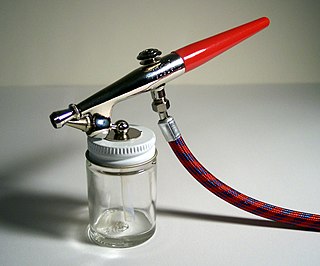
An airbrush is a small, air-operated tool that atomizes and sprays various media, most often paint, but also ink, dye, and foundation. Spray painting developed from the airbrush and is considered to employ a type of airbrush.

A scale model is a physical model which is geometrically similar to an object. Scale models are generally smaller than large prototypes such as vehicles, buildings, or people; but may be larger than small prototypes such as anatomical structures or subatomic particles. Models built to the same scale as the prototype are called mockups.
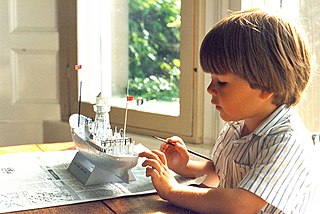
A plastic model kit,, is a consumer-grade plastic scale model manufactured as a kit, primarily assembled by hobbyists, and intended primarily for display. A plastic model kit depicts various subjects, ranging from real life military and civilian vehicles to characters and machinery from original kit lines and pop fiction, especially from eastern pop culture. A kit varies in difficulty, ranging from a "snap-together" model that assembles straight from the box, to a kit that requires special tools, paints, and plastic cements.

Testor Corporation is an American manufacturer of tools and accessories for scale model kits. The business is based in Rockford, Illinois, and is part of RPM International. It was founded in 1929 and its products are made in the US and marketed to customers worldwide.
Model military vehicles range in size and complexity; from simplified small-scale models for wargaming, to large, super-detailed renditions of specific real-life vehicles.
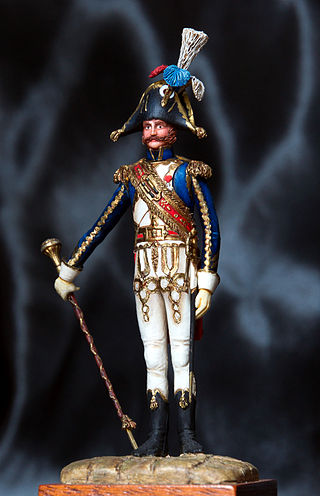
A model figure is a scale model representing a human, monster or other creature. Human figures may be either a generic figure of a type, a historical personage, or a fictional character.
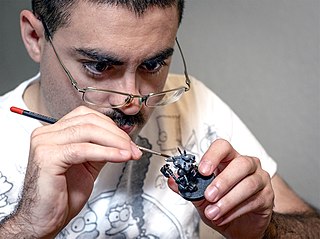
Figure painting, or miniature painting, is the hobby of painting miniature figures and/or model figures, either as a standalone activity or as a part of another activity that uses models, such as role-playing games, wargames, or military modeling.
Model robots are model figures with origins in the Japanese anime genre of mecha. The majority of model robots are produced by Bandai and are based on the Gundam anime metaseries. This has given rise to the hobby's common name in Japan, Gunpla. Though there are exceptions, the model robot genre is dominated by anime tie-ins, with anime series and movies frequently serving as merchandising platform.
A garage kit (ガレージキット) or resin kit is an assembly scale model kit most commonly cast in polyurethane resin.
1:144 scale is a scale used for some scale models such as micro/mini armor. 1:144 means that the dimensions of the model are 1/144 (0.00694) the dimensions of the original life-sized object; this equates to a scale of 1/2 inch per 6 feet of original dimension. For instance, an airplane 30 feet (9.14 m) in length would be a mere 2.5 inches (63.5 mm) long as a 1:144 scale model.
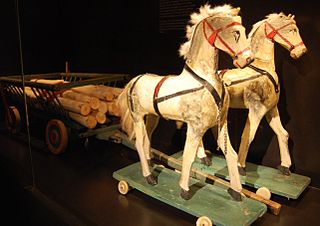
Model horses are scale replicas of real horses. They originated simultaneously – but independently – in the United States, Canada, and the United Kingdom, followed later by Sweden (UK-influenced), Germany (US-influenced), and Australia. They encompass a wide variety of fanbase activities, from those who simply like to collect, to those who show their models at model horse shows. Unlike model cars or trains, model horse collectibles do not need to be assembled from kits, although they can be altered to the collector's liking.
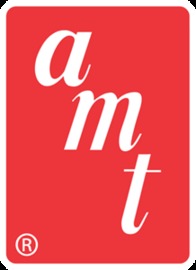
Aluminum Model Toys (AMT) is a toy manufacturing brand founded in Troy, Michigan, in 1948 by West Gallogly Sr. AMT became known for manufacturing 1/25 scale plastic automobile dealer promotional model cars and friction motor models, and pioneered the annual 3-in-1 model kit buildable in stock, custom, or hot-rod versions. The company made a two-way deal in 1966 with Desilu Productions to produce a line of Star Trek models and to produce a 3/4 scale exterior and interior filming set of the Galileo shuttlecraft. It was also known for producing model trucks and movie and TV vehicles.

1:35 scale is the most popular scale for model military vehicles, with an extensive lineup of models and aftermarket parts available from a wide variety of manufacturers.
Resin casting is a method of plastic casting where a mold is filled with a liquid synthetic resin, which then hardens. It is primarily used for small-scale production like industrial prototypes and dentistry. It can be done by amateur hobbyists with little initial investment, and is used in the production of collectible toys, models and figures, as well as small-scale jewellery production.

1:700 scale is a widely popular scale mainly used by Japanese ship model kit manufacturers, such as Aoshima, Tamiya, Hasegawa, Fujimi and Pit-Road.
Gundam Plastic models, Gundam Plamo, or Gunpla are model kits depicting the mecha machinery and characters of the fictional Gundam multiverse by Bandai.














